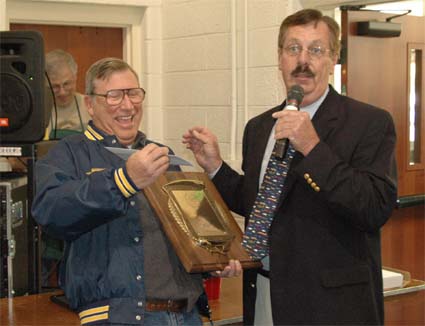 |
Flying High With Electric Power!
The Ampeer ON-LINE!
Fly the Future - Fly Electric! |
Site Table of Contents
| President: | Vice-President: | Secretary/Treasurer: |
| Ken Myers | Richard Utkan | Rick Sawicki |
| 1911 Bradshaw Ct. | 240 Cabinet | 5089 Ledgewood Ct. W. |
| Commerce Twp., MI 48390 | Milford, MI 48381 | Commerce Twp., MI 48382 |
| (248) 669-8124 | (248) 685-1705 | 248.685.7056 |
 | ||
| Board of Directors: | Board of Directors: | Ampeer Editor |
| David Stacer | Arthur Deane | Ken Myers |
| 16575 Brookland Blvd. | 21690 Bedford Dr. | 1911 Bradshaw Ct. |
| Northville, MI 48167 | Northville, MI 48167 | Commerce Twp., MI 48390 |
| 248.924.2324 | 248.348.2058 | 248.669.8124 |
| Mailed Ampeer printed subscriptions are no longer available.
The Ampeer is FREE on-line in Acrobat .pdf format and HTML with active links! | ||
| The Next EFO Meeting: Date: Thursday, December 8 Time: 7:30 p.m. Place: Ken Myers' house (see address above) | ||
|
John passed peacefully, at the age of 87, on October 23, 2011.
Ampeer subscribers received this information in the November email notice that the November Ampeer had posted.
Ken, I am John Worth's daughter, Monica. Wanted to say thanks to you and your fellow flyers for their kind words about my father. Since he spent so many happy hours online with his modeling buddies, near and far, we decided to create a site folks can visit to post a comment or just enjoy his love of flying. If you can help us get the word out, we'd be grateful. www.johnworth.net.
With gratitude,
Social Media
I have received many invitations to Facebook, Linkedin, etc. I do not do "social media" and don't have accounts to any of these new forms of advertising.
Sig Ryan STA E-Power
Hello again Ken, The kit, which I'm building, is a Sig Ryan STA. The kit calls for a .60 two stroke or .90 four stroke. Wingspan is 72". I haven't figured out wing area yet. I figure that the plane will weigh about 8 lb. - 9 lb., by some of the posts which I've read. Looking at motors, I had figured a motor which generated about 1000 to 1200 watts would be adequate, but the Kv remains somewhat of a mystery to me. On your Excel spreadsheet, I plugged in the numbers with a wing area similar to what you have in there as an example. I'm not sure how to choose 6s or higher?
Thanks in advance.
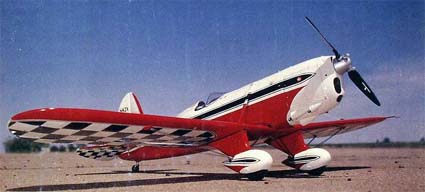
Photo from Original Kit Box Hi Paul, I used the Web's target_blankWayback Machine to locate the info on the Sig RYAN STA SIG Kit No: RC-27. Engine: .60 cu.in. 2-stroke
Retail Price: $179.95 There was no 4-stroke listed at that time (1998), but a .90 4-stroke would have been a typical recommendation then.
|
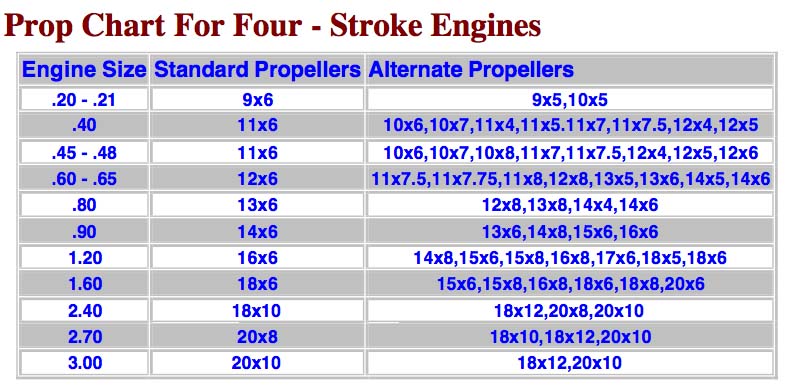
|
It is 'best' to use the 4-stroke displacement's Standard Propellers diameter plus 2", if it will fit and still give about 1.5" of ground clearance. The chart shows the Standard Propellers prop for a .90 4-stroke is a 14x6. That indicates a 16" diameter prop (14" + 2"). The area on the spreadsheet for pitches indicates 11", 12" and 13". I pick the middle pitch when I can, as it gives wiggle room, as the predictions are not 100% accurate, and most manufacturer's Kv number is usually off a bit as well.
|
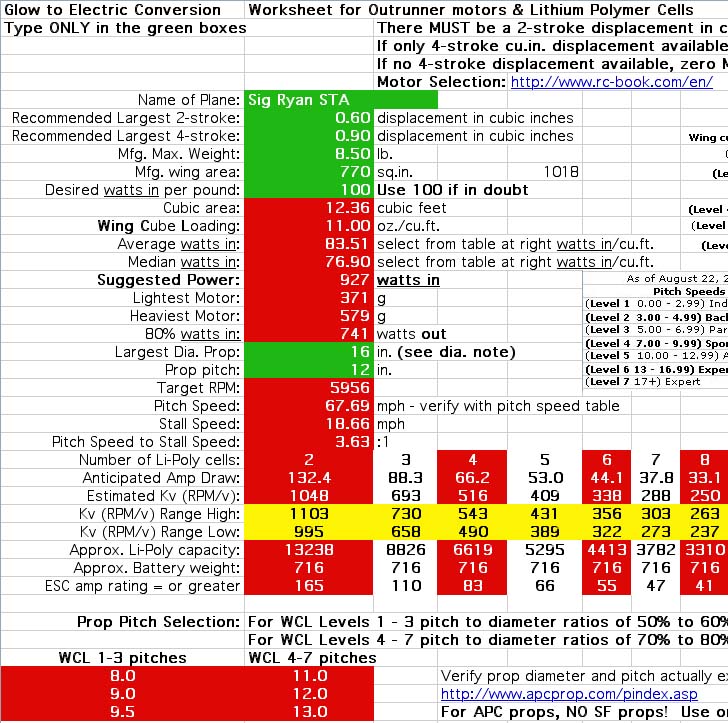
Copy of Excel Workbook page
|
Kv (RPM/v) is a mystery to most folks. Many, many, many people think it has something to do with the volts in. Overall it doesn't. It is the volts out that are there once the voltage drops through the ESC and motor. That remaining voltage combined with the Kv yields the resulting RPM. That is why I created the spreadsheet. It gives the suggested Kv range FOR THE CHOSEN PROP. 6S Kv range: 320 - 355
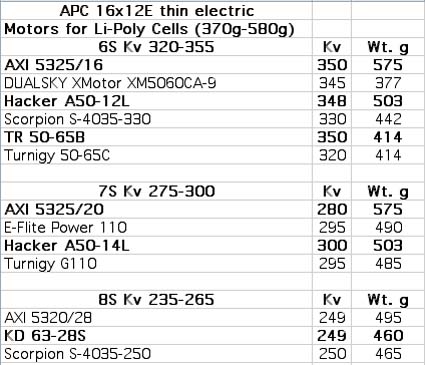 I'm not sure whether or not you read the Guide for the Workbook, but a lot of that is in there. Hope this helps with your project,
For more on glow to electric conversions The specific workbook for this plane is here. EFO September & October Flying Meetings Fall in Michigan is a great time to be at the flying field. Both the September and October EFO Flying Meetings were blessed with great weather. 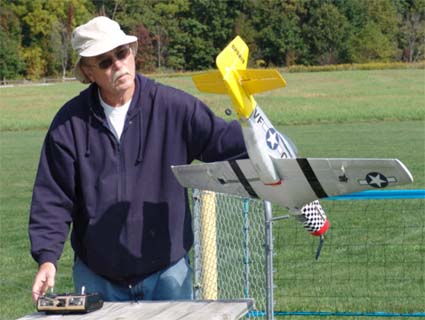 EFO vice-president, Richard Utkan prepares his Mustang in September. 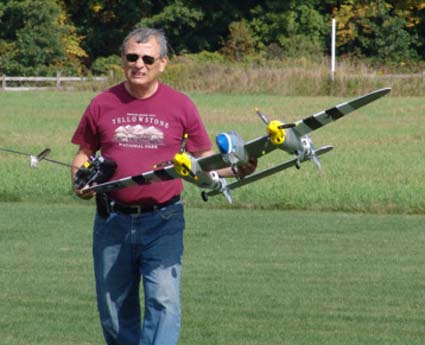 Rich Sawicki returns from a successful flight of his P-38. The grass was short enough for the provided retracts in this Banana Hobby P-38 to work well on this day. 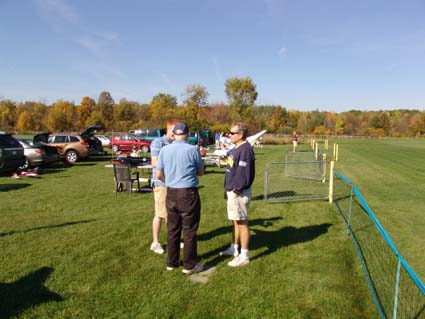 The weather was even better at the October meeting. It was a great day for flying and sharing. 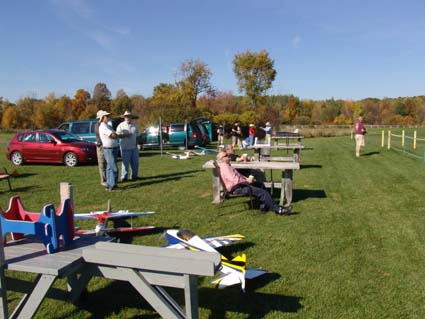 It just doesn't get any better than this. Blue skies and low winds provided the perfect weather. 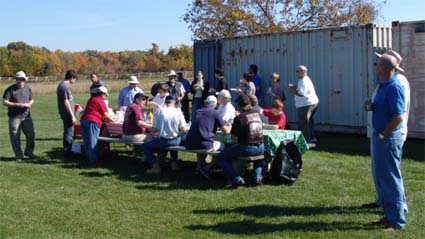 A great 'field lunch' was provided to the fliers. A HUGE hit of the day was Arthur Deane's potato soup. 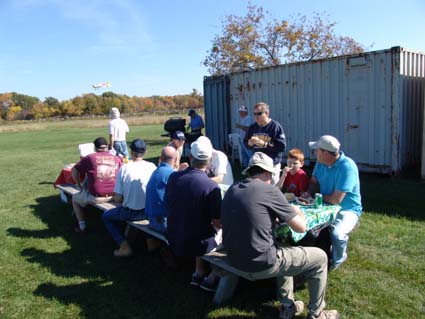 A plane can be seen landing as the folks chow down.
Ken Myers' Glow to Electric Excel Worksheet Questions
Ken, I'm not sure if it's "your" spreadsheet, but it's the one you used and referenced when you showed me how to select a motor for my Venus 40. I'm doing the same thing with my Sig Kadet LT-40. KM: Spreadsheet @ http://www.rcgroups.com/forums/showthread.php?t=1472442 My question is about the Wing Cube Loading level determination. I'm concerned about the fact that the Kadet 40 comes in as a level 3 Park. I just have a hard time using the term "park" and 40-sized trainer in the same sentence. KM: Yes, it is my spreadsheet.
So from there, 2 questions arise: 1. Is it ok to use the next level (level 4 Sport/Trainer) and use the numbers from there? KM: You can change the targeted power by either changing the "Desired watts in per pound" or the WCL level watts in per cubic foot, as you indicated.
2. If I do use the Sport/Trainer numbers, does that drastically change the flying characteristics of the plane? KM: Using the Sport/Trainer numbers does not drastically change the flying characteristics of the plane. The plane will still 'fly' the same. What will change is that, believe it or not, it will be 'over-powered' and harder to trim because of the wide variation between the stall speed and top pitch speed. In more of a fuel engine type question terms, would it be like the difference between a 40 and a 60-sized motor, or more like the difference between an OS 40AX versus some other brand's 40 size? Would that be a major difference versus slight difference as far as weight, pull, etc.? KM: It would be more like the .40 to .60 comparisons with quite a large difference. I've posted a screen capture of the spreadsheet for the LT-40 using an APC 13x6.5E in your 'Show us your Sig LT-40 Conversions' thread on RC Groups. |
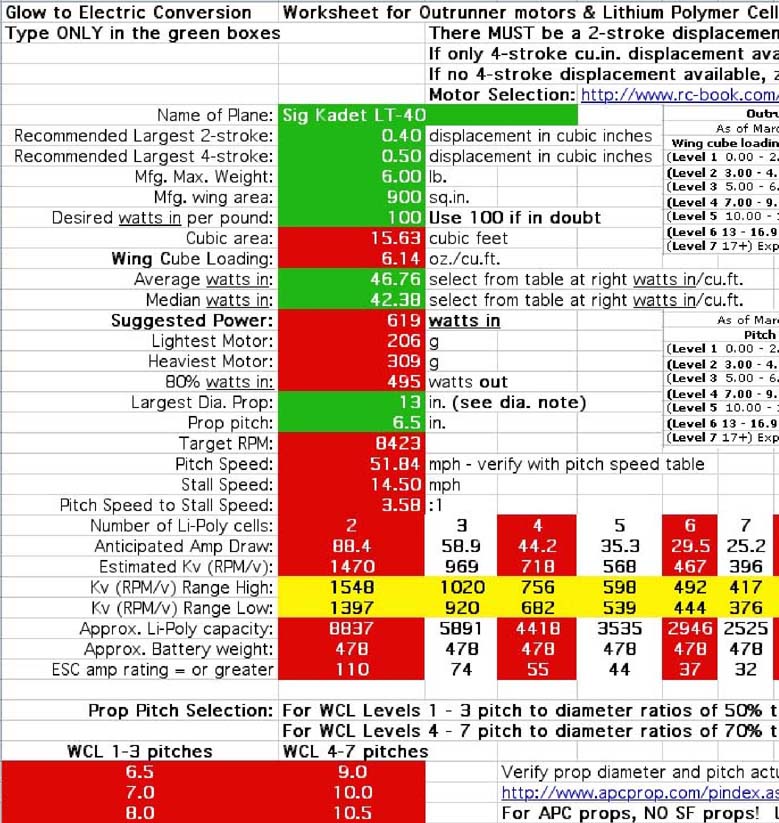
Screen Capture for LT-40
|
You can compare it to what you've been playing with. I also did a motor search for you as well. 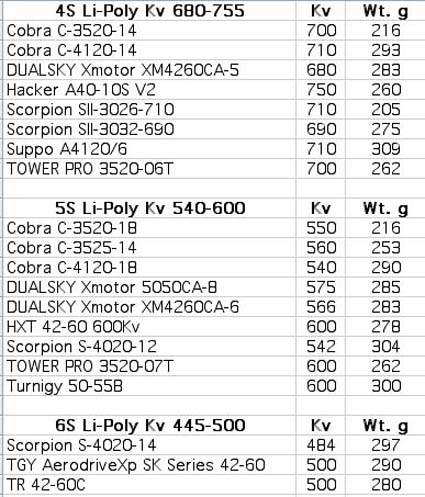 The 13" diameter was chosen because it is 2" larger than the 11" diameter used by a .50 4-stroke and the 6.5" pitch gives a pitch speed of about 50 mph. Notice that the 6.5" pitch falls in the WCL 1-3 part of the table. Yep, back there again. The field I fly at is full of fuel guys. Electrics are still the red headed stepchildren, so I don't have a local guru. I appreciate your time and insight. Adam Lough And a follow-up from Adam Ken, I finally got a Watts Up meter. I put it on the Kadet with a 12x8 and here are the numbers I got:
I'm close to finishing the Venus now.
Thanks for your time, opinions, and consideration.
KM: I used Drive Calculator and it looks like similar motors to the Grayson Hobby motor, which I believe to be a Suppo, when using an APC 14x7E, are about 600 to 650 watts in pulling about 40 to 45 amps on a 4S Li-Poly.
Hope that is helpful. Reminder: Skymasters' Indoor Flying Season
Skymasters R/C of Michigan would like to welcome your club to join us when the Winter Indoor Flying returns on Tuesdays starting November 1st!
More on the E-powered Magic
Hello Ken, Another great issue of the Ampeer. (Referring to the November issue where his Magic conversion was featured. KM)
Take care,
Venus 40 Power System Recommendations
Hi Ken, Venus 40 Power System Recommendations Adam's RC Groups Thread Adam picked a motor with a Kv of 650. As discussed earlier. He might have to drop the prop pitch to 8.5" or possibly even the diameter to 13" to keep the amp draw in a decent range from his ESC and motor combination. The worksheet shows that for a 4S Li-Poly and an APC 14x10E prop, a motor weighing between 220g and 330g with a Kv of about 575 would have been a good choice. |
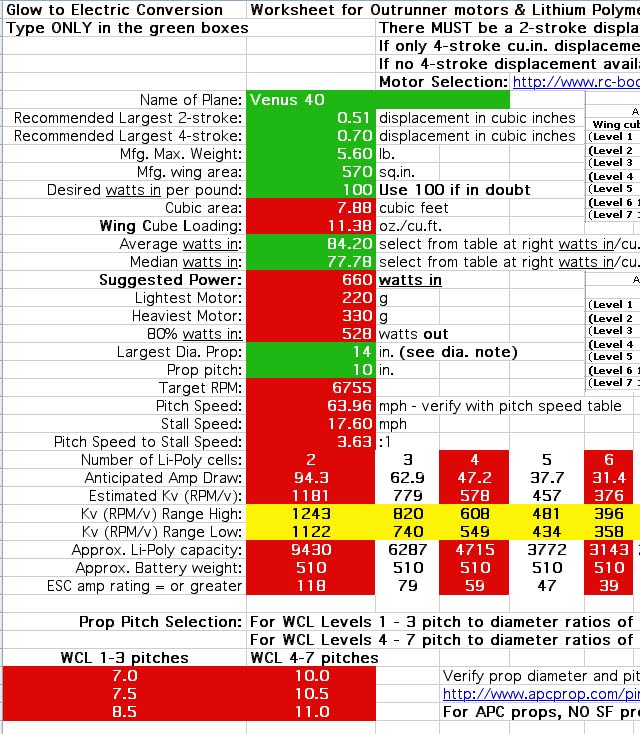
Screen Capture for Venus 40
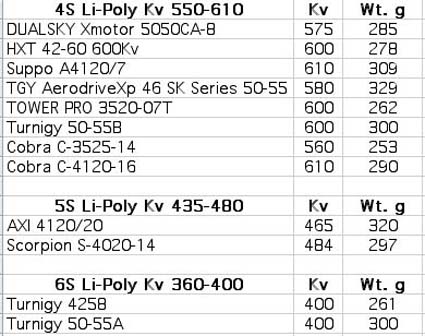
Motors for Venus 40 and 14x10 prop. New Format for Some 'Books' on the EFO Site
Ed Anderson's EVERYTHING YOU WANTED TO KNOW ABOUT ELECTRIC POWERED FLIGHT and Ken Myers' Electric Power Basics now have a new format available on the EFO site. KM I read about Ed's book in this month's Model Aviation, and found a copy on your website. I downloaded it along with your book.
Thanks very much for sharing! Cheers,
Thank you Patrick for sharing them with us! KM Glow to Electric Follow-up Questions Ken, Could you give me a brief/quick/down n dirty explanation as to why when the number of cells goes up, the amp rate of the ESC goes down?
Adam There are a lot of variables when selecting a successful power system for a glow to electric conversion. Some decisions need to be made to limit the number of variables.
p. 54 "ASK YOURSELF THESE THREE QUESTIONS
You'll note that I set a target power in for the Venus at about 660 watts in using the glow to electric spreadsheet as a 'guide'. That input power could be higher or lower and the plane still considered a successful conversion, as demonstrated by Tom's questions. To make it easier for most folks interested in this type of conversion, I just let the formulas on the spreadsheet do their work. For this explanation, we will assume that a Li-Poly cell can supply approximately 3.7v under load at some point in time when we might be measuring it with a power meter. This is only done to make comparing what is going on with the different number of cells easier. It absolutely does not happen in 'real life' for many various factors. Using 3.7v per cell -
660 watts in / 14.8v = about 45 amps required
See this post by Lucien Miller. The 80% 'Rule' is discussed as the second item in his reply. Some folks, including myself, use this 'RULE', while others don't. Like all rules of thumb, only the user can determine if it is useful for their purposes.
4S 45 amps * 1.25 = 56.25 amps (56.25 * 0.8 [80%] = [tah dah] 45) A 55 amp or greater ESC would be appropriate, if you want to follow the 80% 'rule'.
Keep in mind that the 'target' power in is ALWAYS 660 watts in for this example. Selecting the battery. I use a simple method of multiplying the 'target' amp draw by 100. 4S 45 amps x 100 = 4500mAh or slightly greater or less to get a real world capacity
As I previously noted, the weights of similar cells in the given packs will be very close to the same, even though the cell count changes. As the cell count goes up, the capacity, and therefore the weight goes down.
5S 3600mAh (3.6Ah) @ 36 amps - 3.6Ah * 0.8 = 2.88Ah * 60 minutes = 172.8 amp minutes / 36 amps = 4.8 minutes 6S 3000mAh (3.0Ah) @ 30 amps - 3.0Ah * 0.8 = 2.4Ah * 60 minutes = 144 amp minutes / 30 amps = 4.8 minutes The original calculation for the Venus 40 and recommendations were based on using an APC 14x10E prop. Prop selection is a key to all electric power system's success, as well as for glow to electric conversions. Tom Hunt explains why on page 52 of his article and notes, "The biggest advantage to electric flight is to choose a motor/prop combination that swings a large prop that better matches not only the way you want to fly, but the ability of the model to fly in the manner intended." That is why I chose to do the original calculations with a 14x10 prop.
2-stroke 0.40
The spreadsheet has been updated and the numbers for the average and median watts-in per the cubic wing loading are automatically displayed.
And from Adam: I have been using the "magic spreadsheet" to gather parts for my Sig LT40 conversion from fuel to electric. I have a 710kv Scorpion motor. The battery comes out to be a 4 cell, 4500maAh that I have not purchased yet. My question today is, can I use a 5 cell, or even 6 cells with similar/more/less capacity? My speed controller is in the 65-amp range. I'm using the 13x8 prop. Adam's build thread with the maiden info on RC Groups Ken Myers Presented Coveted Goldberg Vital People Award
Ken Myers was awarded the Carl Goldberg Vital People Award in a surprise presentation during the annual Midwest R/C Society Swap Shop in Northville, MI USA on Sunday November 6, 2011. Over 200 modelers were in attendance. Through special arrangements, Ken's wife was there for the award as well.
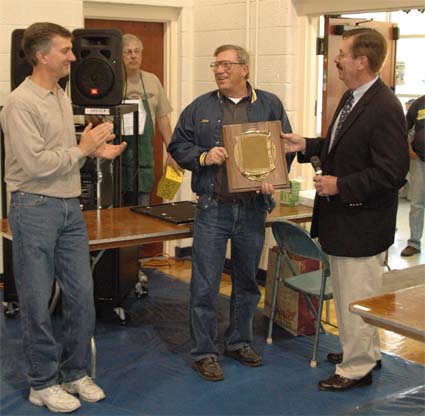
Joe Hass (right) presents Ken's Award as former award winner Gary Weaks (left) looks on The biggest challenge was to keep the award a surprise. Fortunately Ken had moved to the back of the venue as the final preparations went into place. Jim Young graciously agreed to take pictures. At 10 AM Hass took to the microphone. After a brief explanation of the significance of the Goldberg award Ken's name was announced. As applause rose from the crowd Ken, smiling from ear to ear, made his way to the front of room. Reinhardt, who was standing next to Ken, stated that Ken was totally surprised. As evident by one of the pictures Ken was equally surprised by the check that accompanied the award.
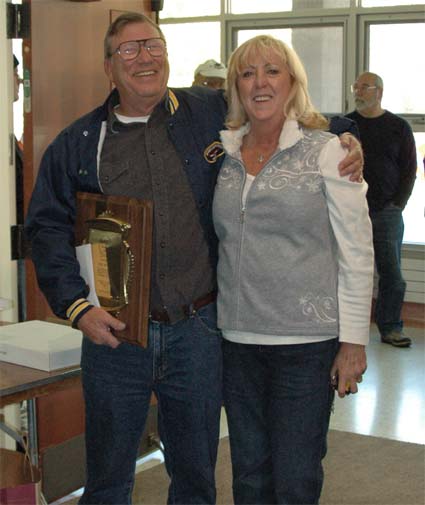
Ken and Chris Myers Wow, all I can say is thanks to everyone! It was indeed a very pleasant surprise! Special thanks to Joe Hass for the nomination and to the AMA for this recognition. Since only five people a year are awarded this honor, I feel extremely honored and humbled. KM There are a precious few individuals who unselfishly contribute to the success of our hobby/sport. To have one who dedicated over 2 decades to the growth and enjoyment of electric flight is truly a gift.
For 23 years Ken Myers has created and edited the AMPEER newsletter. With the masthead of "The Future is Electric" Ken's handiwork has been and continues to be the leading source for data on all things related to electric flight. It is read worldwide. Well before successful electric flight was even imagined Ken's work showed how it could be done.
|
To Reach Ken Myers, you can land mail to the address at the top of the page. My E-mail
address is:
KMyersEFO@mac.com
EFO WEBsite: http://homepage.mac.com/KMyersEFO/

